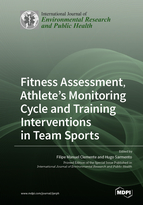Fitness Assessment, Athlete’s Monitoring Cycle and Training Interventions in Team Sports
A special issue of International Journal of Environmental Research and Public Health (ISSN 1660-4601). This special issue belongs to the section "Exercise and Health".
Deadline for manuscript submissions: closed (30 March 2021) | Viewed by 73312
Special Issue Editors
Interests: football; soccer; match analysis; performance analysis; network analysis
Special Issues, Collections and Topics in MDPI journals
Interests: match analysis; talent identification; sports training; team sports; small-sided games
Special Issues, Collections and Topics in MDPI journals
Special Issue Information
Dear Colleagues,
Team sports training is progressively growing, challenging strength and conditioning coaches and head coaches. As part of a well-prepared training strategy, it is important to establish a functional relationship among fitness assessment, load, and well-being monitoring and readiness analysis to identify the consequences of training stimulus for players. Each of these topics has to date been isolated in research; however, it is important to bridge the gap between them and establish a greater and more comprehensive approach among fitness adaptations, training monitoring, and specific interventions performed. This may help us to achieve a clearer view of the big picture in terms of the consequences for players, namely, considering their exposure to successful biological adaptations or less successful cases, such as illness or injuries.
As it is clear that more research should be done on the relationship among these dimensions and topics, the aim of the Special Issue on "Fitness Assessment, Athlete’s Monitoring Cycle and Training Interventions in Team Sports" is to publish high-quality original investigations, systematic reviews, and meta-analysis in the research field of team sports.
We look forward to receiving contributions related (but not limited) to the following topics:
- performance assessment and relationships between fitness measures;
- training load monitoring, well-being, and readiness in team sports;
- training interventions;
- complementary strategies for performance (e.g., nutrition, supplementation, psychology, injury preventions, recovery); and
- determinants of illness and injuries in players. We welcome papers related to evidence of successful intervention strategies. All manuscripts will be peer-reviewed by experts in the field.
Dr. Filipe Manuel Clemente
Dr. Hugo Sarmento
Guest Editors
Manuscript Submission Information
Manuscripts should be submitted online at www.mdpi.com by registering and logging in to this website. Once you are registered, click here to go to the submission form. Manuscripts can be submitted until the deadline. All submissions that pass pre-check are peer-reviewed. Accepted papers will be published continuously in the journal (as soon as accepted) and will be listed together on the special issue website. Research articles, review articles as well as short communications are invited. For planned papers, a title and short abstract (about 100 words) can be sent to the Editorial Office for announcement on this website.
Submitted manuscripts should not have been published previously, nor be under consideration for publication elsewhere (except conference proceedings papers). All manuscripts are thoroughly refereed through a single-blind peer-review process. A guide for authors and other relevant information for submission of manuscripts is available on the Instructions for Authors page. International Journal of Environmental Research and Public Health is an international peer-reviewed open access monthly journal published by MDPI.
Please visit the Instructions for Authors page before submitting a manuscript. The Article Processing Charge (APC) for publication in this open access journal is 2500 CHF (Swiss Francs). Submitted papers should be well formatted and use good English. Authors may use MDPI's English editing service prior to publication or during author revisions.
Keywords
- fitness assessment
- load monitoring
- well-being
- readiness
- training interventions
- strength and conditioning
- nutritional and supplementation strategies
- recovery strategies
- injury prevention
- injuries epidemiology
- illness
- performance analysis







